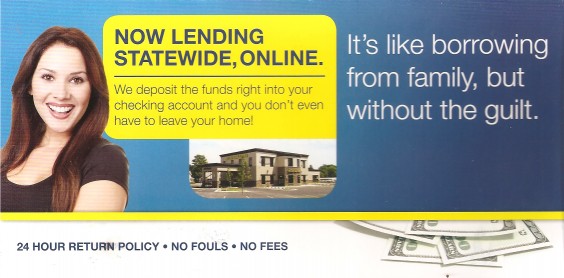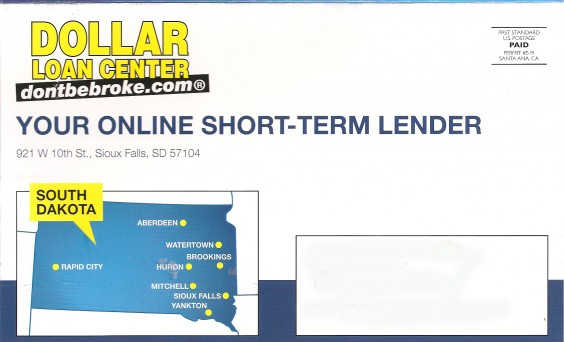Whoa.
That was my first reaction to the direct mail piece that arrived in my mailbox today. Upon further reflection, I’m still pretty much flabbergasted that this is legal.
Here’s what I saw on the outside:
My online short-term lender! And look at all those convenient South Dakota locations. A Sioux Falls company—gotta appreciate a local business, right? So far nothing too strange.
Then this is on the other side:
 Once again, so convenient—you don’t even have to leave your home! And that message: Isn’t it nice you could borrow money and not have to bother family about it? Yes, borrowing from family would make you feel a little guilty—they are struggling too, after all.
Once again, so convenient—you don’t even have to leave your home! And that message: Isn’t it nice you could borrow money and not have to bother family about it? Yes, borrowing from family would make you feel a little guilty—they are struggling too, after all.
But maybe this ad is trying to say something else here. Maybe, just maybe, it is suggesting you really shouldn’t tell your family member about your money problem—far better to just head on down to the payday loan place as your own personal business. That way Dollar Loan gets your business—and your family member doesn’t have a chance to talk you out of it.
If I were going to ask a family member for a loan, I’d have an awfully good reason for it. I wouldn’t want to risk souring that relationship over something unnecessary. These guys are encouraging you to step around that gate. You don’t need a good reason to borrow money! If you want something, you can have it today! “Don’t be broke!” (Notice the slogan in their website—if you didn’t have money for groceries, would you say, “Sorry, I can’t buy food today, I’m broke”? Probably not. If you were such dire straits, you likely wouldn’t be talking about it. “I’m broke” is something we say to our friends when we can’t chip in for pizza. I’m sure there are exceptions, but it’s most often about wants, not needs.)
OK, but what are the terms? That’s on the inside:
Wow, there are no limits to this! You can borrow as much money as you want! They don’t care if you have bad credit, or even if you’ve been bankrupt! And the payments are “small,” and it’s all “confidential”—no need to tell your family about what you want to do. And look the cost—just $4.99! How cheap is that?
Wait, that’s $4.99 a day … so if you don’t get paid for 10 days, that’s … hmm … about $50. But that’s not so much, right? If you really, really need your $500 now?
Now here’s the fine print:
The APR (annual percentage rate) is … 363.01%.
What?!
And keep reading: “The amount of the finance charge is $1768.91.” So, for the luxury of having your $500 early, you could pay $1768.91 after 65 weeks.
OK, let’s put that in context. Head on down to your bank or credit union for a consumer credit loan, and the rate is somewhere between 3 and 12 percent, depending on the term of the loan, your credit history, and how the bank scores your application (according to numbers from my own credit union). Credit cards have a reputation for facilitating debt, especially if you only pay the minimum balance each month, but the typical APR for a credit card (once you get past the low introductory offers) is somewhere in the teens—the average is 14.9 percent.
How in the world can someone legally charge 363%?
The payday lenders argue that there is a need for their service—not everyone can get a loan at a bank or credit union, and some people do not have credit cards at their disposal either. These payday loan folks say they are taking on risk on those with bad credit or bankruptcy in their past, which is why they need to charge more to cover that risk.
That’s not to say that no one has objected to these practices. A federal law enacted in 2007 makes it illegal to charge military personnel more than 36 percent interest. Payday lending practices have been restricted in 15 states; a law that would have restricted APRs to 72 percent was proposed in the South Dakota Legislature in 2010 but was tabled.
During such debates, payday lenders often bring up the analogy of getting a ride in a taxi: You wouldn’t pay $20 for a ride every day in your own car, but for the short-term convenience of getting a ride when you need it, you pay the $20. They say their product is intended just to get people to the next payday, so bringing up a year-long measurement isn’t fair or relevant.
A recent study by the Pew Charitable Trusts suggests that this taxi analogy doesn’t work as well when a couple other facts are considered:
Existing data show that, in at least two significant respects, the payday lending market does not function as advertised. First, payday loans are sold as two-week credit products that provide fast cash, but borrowers actually are indebted for an average of five months per year. Second, despite its promise of “short-term” credit, the conventional payday loan business model requires heavy usage to be profitable—often, renewals by borrowers who are unable to repay upon their next payday. (emphasis added)
So, in practice, it’s more like a free ride in a taxi, but then realizing later you’ve actually been paying for that ride for five months. The “free ride” cost $30, plus the driver dropped you off where you started from. And that taxi driver has a business model that requires charging you rates much higher than other taxi drivers down the street. More people might opt not to take the ride if they knew what typically happens to borrowers.
The Pew study also found that 69 percent of respondents had used payday loans for the first time to deal with recurring expenses, compared to just 16 percent who used it for emergency expenses. (I think the advertisement I received is trying to get more people to join the 8 percent of respondents who said they first got a payday loan to pay for “something special” like a trip or holiday shopping.)
Industry, advocates, and regulators all suggest that using payday loans for recurring expenses is not an effective use of high-cost credit and that, rather, such credit should be used to cover unexpected expenses for a short period of time. Yet, previous research, as well as discussions with industry leaders, and state-level reports, all make clear that a typical borrower uses payday loans many times per year, and much of this borrowing comes in relatively quick succession once someone begins using payday loans. (emphasis added)
Each year, the average payday loan borrower gets eight loans of $375 each, and ends the year paying $520 in interest.
The rest of the report is a good read. (Another good tidbit: Some payday loan customers are under the mistaken impression that they are getting a better deal than they would by putting expenses on their credit card.) Perhaps someone could lend copies to the convenient payday loan locations in South Dakota? For just $4.99 a day, they could keep it as long as they liked!
 Dakotafire Get your spark here.
Dakotafire Get your spark here.





